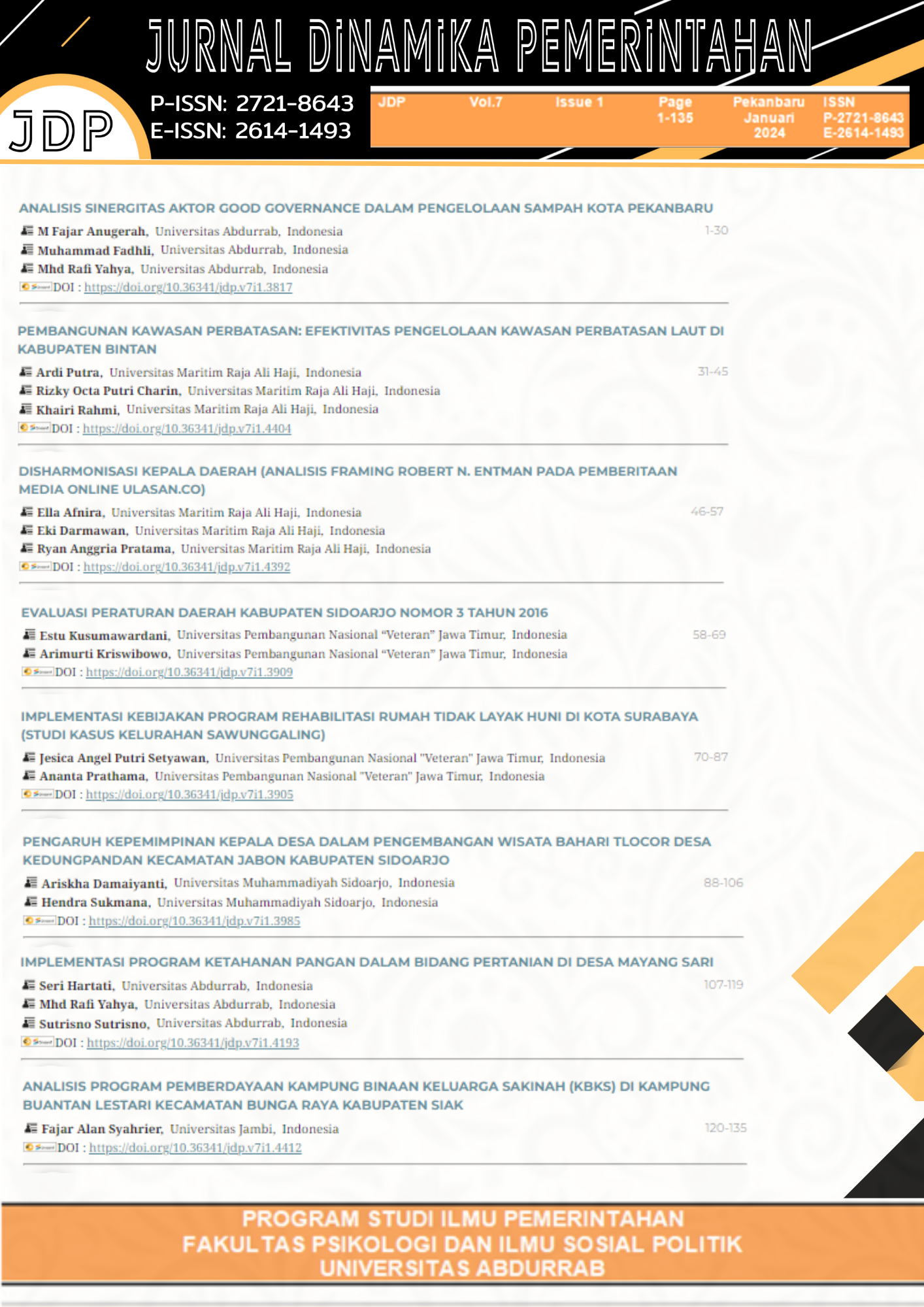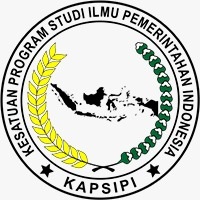EVALUASI PERATURAN DAERAH KABUPATEN SIDOARJO NOMOR 3 TAHUN 2016
Abstract
The Sidoarjo Regency Government created Sidoarjo Regency PERDA Number 3 of 2016 concerning the Arrangement and Empowerment of Street Vendors as a response to the proliferation of street vendors. One of the street vendors that is of concern is Gading Fajar street vendors, numbering 1,200 street vendors. This research aims to determine the evaluation of Sidoarjo Regency PERDA Number 3 of 2016 using a qualitative case study method written descriptively. This PERDA evaluation uses the theory of William N. Dunn (2003) which has six criteria, namely effectiveness, efficiency, adequacy, alignment, responsiveness and accuracy. The research results show that based on effectiveness criteria, PERDA is still not effective because the achievement of objectives and involvement of the authorities has not been optimal. However, there is effectiveness in monitoring the arrangement of street vendors by the Sidoarjo Regency Satpol PP. From the efficiency criteria, it shows that the arrangement of street vendors is efficient in terms of time and resources, but not yet efficient in terms of costs. From the adequacy criteria, it shows that the PERDA is not sufficient as a guideline for structuring and empowering street vendors because the Sidoarjo Regency Cooperatives and Micro Enterprises Service has not implemented it optimally so that the Sidoarjo Regency Satpol PP is more dominant in enforcing it themselves. From the leveling criteria, it shows that the distribution of facilities and infrastructure and the distribution of costs is still not evenly distributed, but there is some leveling in socialization by the Sidoarjo Regency Satpol PP. From the responsiveness criteria, it shows that the Sidoarjo Regency Cooperatives and Micro Enterprises Service and the Sidoarjo Regency Satpol PP received various responses of acceptance and rejection but they were able to overcome them and Gading Fajar Street Vendors continue to wait for empowerment from the authorities. From the accuracy criteria, it shows that the accuracy of objectives and benefits are still not balanced because its implementation in Gading Fajar is still focused on structuring and has not yet led to empowerment.
References
Abdal. (2015). Kebijakan Publik (Memahami Konsep Kebijakan Publik). Bandung : LPPM UIN Sunan Gunung Djati Bandung
Akbar, F., & Mohi, W. K. (2018). Studi Evaluasi Kebijakan (Evaluasi Beberapa Kebijakan di Indonesia). Gorontalo : Ideas Publishing
Alamsyah, K. (2016). Kebijakan Publik Konsep dan Aplikasi. Bandung : Media Citra Mandiri Press
Anggara, S. (2014). Kebijakan Publik. Bandung : Pustaka Setia Bandung
Aslinda. (2023). Model Kebijakan Publik dan Teori Perubahan Kebijakan. Yogyakarta : K-Media
Dewi, D. S. K. (2022). Buku Ajar Kebijakan Publik : Proses, Implementasi dan Evaluasi. Yogyakarta : Penerbit Samudra Biru
Dunn, W. (2003). Pengantar Analisis Kebijakan Publik Edisi Kedua. Yogyakarta : Gadjah Mada University Press
Indiati. (2021). Buku Ajar Pengantar Kebijakan Publik. Malang : Sekolah Tinggi Ilmu Sosial dan Ilmu Politik Waskita Dharma Malang
Marhawati. (2020). Analisis Pendapatan Pedagang Kaki Lima Sektor Informal di Kecamatan Rappocini Kota Makassar. Jurnal Ekonomi Dan Pendidikan, 3(1), 68–76. https://doi.org/10.26858/jekpend.v3i1.12374
Meutia, I. F. (2013). Analisis Kebijakan Publik. Bandar Lampung : Aura CV. Anugrah Utama Raharja
Mustari, N. (2015). Pemahaman Kebijakan Publik (Formulasi, Implementasi dan Evaluasi Kebijakan Publik). Yogyakarta : Leutikaprio
Peraturan Menteri Dalam Negeri Nomor 41 Tahun 2012 Tentang Pedoman Penataan Dan Pemberdayaan Pedagang Kaki Lima
Peraturan Daerah Kabupaten Sidoarjo Nomor 3 Tahun 2016 Tentang Penataan Dan Pemberdayaan Pedagang Kaki Lima
Pramono, J. (2020). Implementasi dan Evaluasi Kebijakan Publik. Surakarta : Unisri Press
Pratiwi, D. C., & Kriswibowo, A. (2022). Implementasi Peraturan Menteri Pemberdayaan Perempuan dan Perlindungan Anak Nomor 11 Tahun 2011 Tentang Kebijakan Pengembangan Kabupaten/Kota Layak Anak di Surabaya. Populis : Jurnal Sosial Dan Humaniora, 7(2), 192. https://doi.org/10.47313/pjsh.v7i2.1867
Rahayu, M. J., Werdiningtyas, R., & Musyawaroh. (2016). Faktor-Faktor Yang Mempengaruhi Keberhasilan Penataan PKL Sebagai Strategi Penataan Ruang Kota Surakarta. Jurnal Region, 7(2), 109–122. https://doi.org/10.20961/region.v7i2.11582
Ravyansyah, Purba, S., Irawan, B., Fathur, A., Purnama, E., Wiwin, K., Sudiartini, N. W. A., Haris, A., Suwardi, A, M. D. S., & Sari, D. (2022). Kebijakan Publik. Padang : PT. Global Eksekutif Teknologi
Sawir, M. (2021). Ilmu Administrasi Dan Analisis Kebijakan Publik Konseptual Dan Praktik. Yogyakarta : Deepublish Publisher
Sulistyo, T. P., & Kriswibowo, A. (2023). Policy Output Analysis dalam Penanganan Kekerasan Terhadap Anak di Dinas DP2KBP2 Kabupaten Mojokerto. 4(2), 481–493.
Tahir, A. (2018). Kebijakan Publik Dan Good Governancy. Gorontalo : Alfabeta
Tarmudzi, I. (2015). Perlindungan Hukum Terhadap Pekerja Anak Di Sektor Informal. Al-Jinayah: Jurnal Hukum Pidana Islam, 1(2), 499–527. https://doi.org/10.15642/aj.2015.1.2.383-398
Taufiqurokhman. (2014). Kebijakan Publik Pendelegasian Tanggung Jawab Negara Kepada Presiden Selaku Penyelenggara Pemerintahan. Jakarta : Fakultas Ilmu Sosial dan Ilmu Politik Universitas Moestopo Beragama Pers
Yusuf, M. (2013). Metode Penelitian Kuantitatif, Kualitatif & Penelitian Gabungan. Padang : Kencana

This work is licensed under a Creative Commons Attribution-NonCommercial-ShareAlike 4.0 International License.
1. Copyright of all journal manuscripts is held by the JDP (Jurnal Dinamika Pemerintahan)
2. Formal legal provisions to access digital articles of electronic journal are subject to the provision of the Creative Commons Attribution-ShareAlike license (CC BY-NC-SA), which means that JDP (Jurnal Dinamika Pemerintahan) is rightful to keep, transfer media/format, manage in the form of databases, maintain, and publish articles.
3. Published manuscripts both printed and electronic are open access for educational, research, and library purposes. Additionally, the editorial board is not responsible for any violations of copyright law.
licensed under a Creative Commons Attribution-ShareAlike 4.0 International License.
 PDF (Bahasa Indonesia)
PDF (Bahasa Indonesia)
 Abstract views: 74
Abstract views: 74
 downloads: 69
downloads: 69

 :
:









